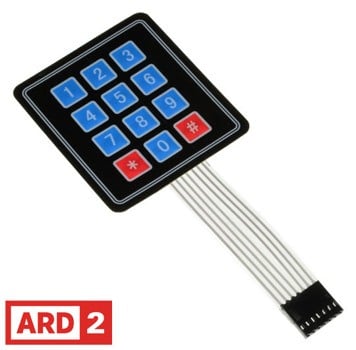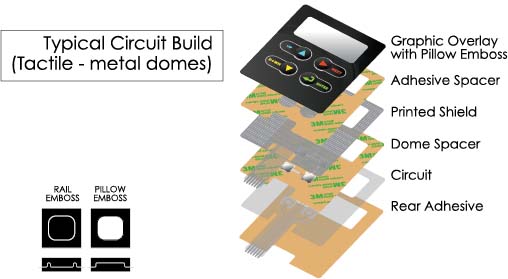How to Choose the Right Membrane Switch for Your Next Project
How to Choose the Right Membrane Switch for Your Next Project
Blog Article
Comprehending Membrane Changes: The Secret to Resilient and Dependable Controls
Membrane layer changes represent a crucial element of modern user interface design, mixing performance with durability in numerous applications. These flexible elements not only help with user communication but are additionally crafted to hold up against the rigors of requiring atmospheres, from medical tools to industrial machinery. Comprehending their building, procedure, and the myriad benefits they supply is necessary for engineers and designers alike. As we check out the complexities of membrane layer buttons, it becomes clear that their function in enhancing control systems is both intricate and profound, questioning regarding exactly how ideal to leverage their capacities in future technologies.
What Are Membrane Buttons?
Membrane buttons are a sophisticated option in the realm of interface technology, integrating functionality and style flawlessly. These gadgets act as an interface in between individuals and digital systems, incorporating several parts right into a portable style. Usually built from adaptable, slim layers of products, membrane layer switches are created to react to touch, allowing individuals to engage with machinery and digital gadgets properly.
The key aspects of a membrane button consist of a printed circuit layer, graphic overlay, and a spacer layer that prevents unexpected activation. The graphic overlay can be customized to mirror brand identification or customer choices, improving appearances while ensuring usability. Membrane layer switches are frequently utilized in various applications, consisting of medical gadgets, consumer electronics, and commercial devices, owing to their durability and resistance to environmental variables such as wetness and dirt.
One of the key benefits of membrane layer switches is their capacity to hold up against wear and tear, making them perfect for high-traffic environments. Additionally, they are light-weight and call for marginal space, enabling for ingenious layouts in item growth. Generally, membrane changes represent a functional and efficient selection for contemporary electronic interfaces, marrying innovation with user-centric style concepts.

Just How Membrane Layer Changes Job
The procedure of membrane layer changes depend upon a basic yet efficient mechanism that equates user input into digital signals. These switches include multiple layers, typically consisting of a visuals overlay, a spacer layer, and a circuit layer. When a customer presses the switch, the leading layer warps, enabling a conductive element in the circuit layer to reach an equivalent conductive pad on the bottom of the visuals overlay. This get in touch with closes the circuit and sends out an electronic signal to the tool, suggesting that the button has actually been triggered.
The layout of membrane buttons can vary, however they frequently include domes or tactile elements to give comments to the customer, boosting the general experience. The products used in membrane buttons, such as polyester or polycarbonate, contribute to their durability and resistance to ecological aspects, including dampness and dust. The published circuits are usually enveloped, which safeguards them from wear and tear over time.

Advantages of Membrane Layer Switches
Among the main benefits of membrane buttons is their convenience in layout, permitting them to be personalized to meet particular customer requirements and visual requirements. This adaptability reaches numerous industries, where various shapes, dimensions, and colors can be utilized to boost individual communication and aesthetic appeal.
In addition, membrane layer buttons are understood for their sturdiness. Created from robust products, they are resistant to dirt, wetness, and physical wear, which dramatically extends their life-span contrasted to typical mechanical switches. This longevity makes them especially appropriate for pop over here high-traffic environments and applications needing long life.

In addition, membrane layer buttons provide a structured profile, resulting in a thinner style that can be incorporated into numerous tools without including bulk. This attribute not only improves the visual charm yet also contributes to a much more ergonomic item design.

Applications of Membrane Buttons
Easy to use and versatile, membrane buttons discover applications across a vast array of markets, consisting of medical devices, consumer electronic devices, and industrial equipment. In the clinical area, these buttons are essential to devices such as analysis tools, person tracking systems, and mixture pumps, where dependability and convenience of cleansing are vital. Their ability to stand up to rough settings and preserve functionality makes them excellent for such applications.
In consumer electronic devices, membrane switches are made use of in items like microwaves, cleaning equipments, and push-button controls - membrane switch. Their smooth style permits user-friendly customer interfaces, boosting the total user experience while supplying longevity and resistance to tear and put on
Commercial equipment also gains from membrane layer buttons, particularly in control panels for machinery and automation systems. These buttons supply protection against dirt and dampness, guaranteeing regular efficiency in difficult atmospheres. Their adjustable functions permit makers to tailor them to specific functional demands, boosting her comment is here effectiveness and functionality.
Selecting the Right Membrane Layer Switch
When choosing a membrane layer button, it is vital to consider different aspects that influence performance and viability for certain applications. The main factors to consider include ecological problems, responsive responses, toughness, and design requirements.
First, examine the operating environment; switches revealed to dampness, chemicals, or severe temperatures need certain products to make certain longevity and performance. Next off, evaluate the demand for tactile comments. Relying on individual interaction, some applications might take advantage of a tactile response to validate activation, while others may choose a non-tactile layout for aesthetic reasons.
Sturdiness is an additional important element; membrane layer buttons ought to be made to hold up against frequent usage, impacts, and abrasion. Ensure the selected switch can withstand the anticipated lifecycle, especially in high-usage situations.
Verdict
In conclusion, membrane switches over offer as vital parts in the design of trustworthy and durable control systems across numerous markets. The flexibility of membrane layer switches over enables for customized services that satisfy specific functional needs, enhancing their significance in contemporary technology.
Membrane layer switches represent an important aspect of modern-day user interface style, mixing performance with strength in different applications.Membrane buttons are a sophisticated remedy in the realm of user interface innovation, incorporating performance and style perfectly. Typically built from adaptable, thin layers of products, membrane layer switches are created to react to touch, allowing customers to communicate with equipment and digital tools effectively.
The style of membrane layer switches can vary, however they usually incorporate domes or responsive elements to supply responses to the user, enhancing the overall experience.In final thought, membrane switches over offer as important components in the design of resilient and trustworthy visit site control systems throughout numerous industries.
Report this page